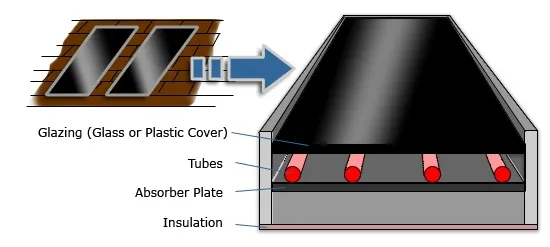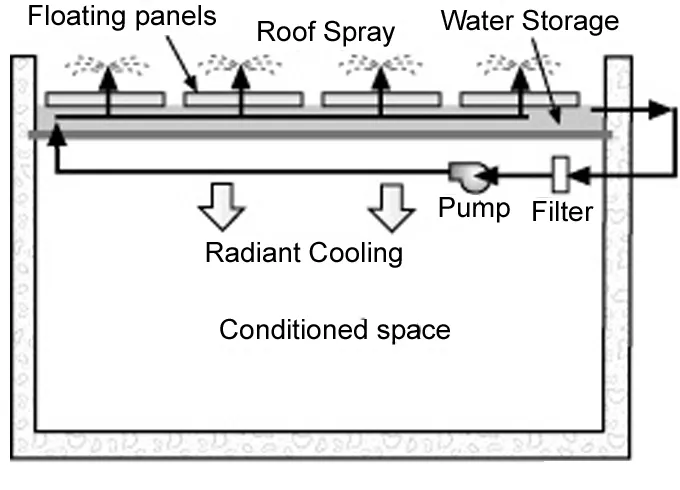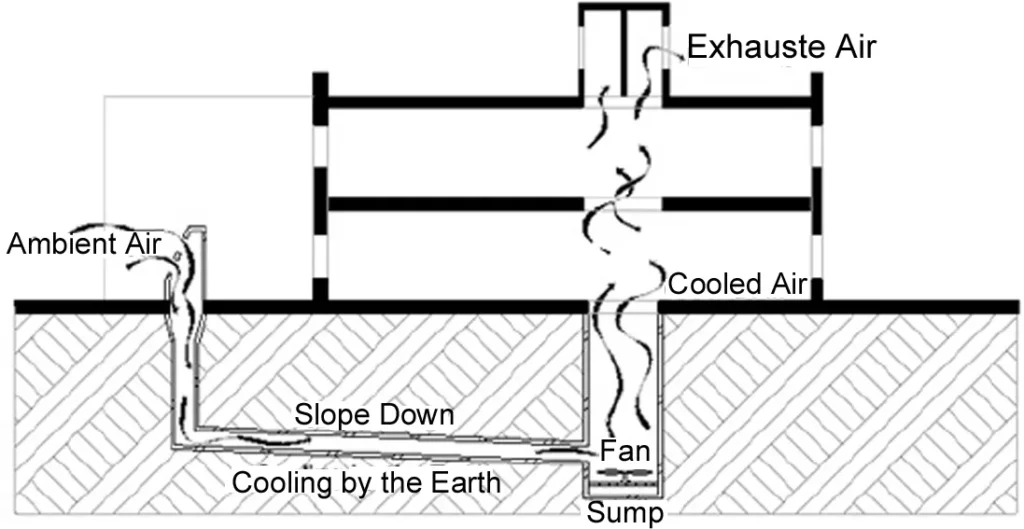If you want to know about the climate specific design principles or passive cooling or sustainable site planning, please click the link.
Active and passive solar architecture are two different approaches to designing buildings that take advantage of the sun’s energy for heating, cooling, and lighting.
- The term solar architecture refers to an approach to building design that is sensitive to Nature and takes advantage of climatic conditions to achieve human comfort rather than depending on artificial energy that is both costly and environmentally damaging.
- It might be difficult to distinguish between active and passive solar system. We’ve determined their primary differences, as well as the functionality and general performance of both systems.
- Although both active and passive solar system can convert the sun’s rays into direct electricity, their mechanics are slightly different.

1) Active solar architecture
- Solar systems that collect solar radiation and convert it to heat in the form of water, air, or another fluid are known as active solar systems.
- Active solar systems use solar panels for heat collection and electrically driven pumps or fans to transport the heat or cold to the required spaces.
- Electronic devices are used to regulate the collection, storage and distribution of heat within the system.
- These solar systems may be utilized to improve the efficiency of your solar system, which is one of the key advantages of employing them.

Hybrid systems using a balanced combination of active and passive features provide the best performance.
- The following are some of the most important characteristics of active solar systems:
- Flat-plate PV panels, which are normally linked and non-movable, make up the active solar collectors. These panels are connected to form modules in high-level designs.
- To collect and convert power, these collectors use liquid or air as conductors. Hydronic collectors are active solar systems that use liquid, whereas air collectors are active solar systems that use air.
- Fluid conductors are more common than air conductors because transmitting energy through a liquid is usually more efficient. Air-based active solar systems, on the other hand, do not freeze
i) Active heating
- In active systems, solar collectors are used to convert sun’s energy into useful heat for hot water, space heating or industrial processes.

- Flat-plate collectors are typically used for this purpose. These most often use light-absorbing plates made of dark coloured material such as metal, rubber or plastic that are covered with glass. The plates transfer the heat to a fluid, usually air or water flowing below them and the fluid is used for immediate heating or stored for later use. There are two basic types of liquid based active systems- open loop and closed loop.

- Solar ponds have been developed, which harness the sun’s energy that can be used for various purposes including production of electricity.
- Other devices such as solar cookers, water distillation systems, solar dryers, etc. have been developed which can be used to reduce energy requirements in domestic households and in industrial applications.
ii) Active cooling
- Absorption cooling systems transfer a heated liquid from the solar collector to run a generator or a boiler activating the refrigeration loop which cools a storage reservoir from which cool air is drawn into the space. Rankine steam turbine can also be powered by solar energy to run a compressed air-conditioner or water cooler.
- Solar refrigeration is independent of electric supply and without any moving parts, for example, Zeolite refrigerator.
Advantage of active solar architecture
- Clean, good for the environment, and reduces your carbon footprint.
- It can reduce or eliminate your heating bills depending on the size of your system.
- Active solar is more efficient than passive solar. Mechanical elements increase the effectiveness of such systems.
- It often has a higher capacity than passive solar.
- Solar installation companies can retrofit solar technology to an existing building.
Disadvantage of active solar architecture
- Active solar technology is expensive. Solar collectors, heat exchangers (for hot water), and ventilation systems (for solar air heaters) can cost a considerable amount.
- The technology takes up space both inside and outside of the home.
- Active solar systems need to be maintained and can sometimes break down.
- It requires external power sources to operate pumps, fans, and any electrical control systems.
- Solar collectors can be unattractive to some people.
2) Passive solar architecture
- It relies upon the design or architecture of the building itself to ensure climate control by way of natural thermal conduction, convection and radiation.
- The rudiments of solar passive design were developed and used through the centuries by many civilizations across the globe; in fact, many of these early civilizations built dwellings that were better suited to their climatic surroundings than those built today in most developed and developing countries.
- The use of solar passive measures such as natural cross ventilation, sufficient day-lighting, proper insulation, use of adequate shading devices coupled with auxiliary energy systems that are renewable and environment friendly can considerably bring down the costs as well as the energy needs of the building.
- ‘Passive design/architecture’ is design that works with the local climate to maintain a comfortable temperature in the home.
- Good passive design should reduce or eliminate the need for additional heating or cooling depending on your location and often relies on an active occupant to work properly.
- A passively designed home can deliver a lifetime of thermal comfort, low energy bills, and low greenhouse gas emissions.
- The term passive solar refers to systems that absorb, store and distribute the sun’s energy without relying on mechanical devices like pumps and fans, which require additional energy. Passive solar design reduces the energy requirements of the building by meeting either part or all of its daily cooling, heating and lighting needs through the use of solar energy.
- With passive design, building features such as orientation, thermal mass, insulation and glazing work together to take advantage of natural sources of heating and cooling, such as sun and breezes, and to minimise unwanted heat gain and loss.
i) Passive heating
- Heating the building through the use of solar energy involves the absorption and storage of incoming solar radiation, which is then used to meet the heating requirements of the space.
- Incoming solar radiation is typically stored in thermal mass such as concrete, brick, rock, water or a material that changes phase according to temperature.
- Incoming sunlight is regulated by the use of overhangs, awnings and shades while insulating materials can help to reduce heat loss during the night or in the cold season.
- Vents and dampers are typically used to distribute warm or cool air from the system to the areas where it is needed.
- The three most common solar passive systems are direct gain, indirect gain and isolated gain.

- A direct gain system allows sunlight to windows into on occupied space where it is absorbed by the floor and walls.
- In the indirect gain system, a medium of heat storage such as wall, in one part of the building absorbs and stores heat, which is then transferred to the rest of the building by conduction, convection or radiation.
- In an isolated gain system, solar energy is absorbed in a separate area such as greenhouse or solarium, and distributed to the living space by ducts. The incorporation of insulation in passive systems can be effective in conserving additional energy.
ii) Passive cooling
- Passive solar technology can also be used for cooling purposes.
- These systems function by either shielding buildings from direct heat gain or by transferring excess heat outside.
- Carefully designed elements such as overhangs, awnings and eaves shade from high angle summer sun while allowing winter sun to enter the building.
- Excess heat transfer can be achieved through ventilation or conduction, where heat is lost to the floor and walls.
- A radiant heat barrier, such as aluminium foil, installed under a roof is able to block upto 95% of radiant heat transfer through the roof.
- Water evaporation is also an effective method of cooling buildings, since water absorbs a large quantity of heat as it evaporates. Fountains, sprays and ponds provide substantial cooling to the surrounding areas. The use of sprinkler systems to continually wet the roof during the hot season can reduce the cooling requirements by 25%. Trees can induce cooling by transpiration, reducing the surrounding temperature by 4 to 14 degrees F. Passive indirect evaporative cooling techniques include roof spray and roof pond systems.
- Roof spray – The exterior surface of the roof is kept wet using sprayers. The sensible heat of the roof surface is converted into latent heat of vaporization as the water evaporates. This cools the roof surface, and a temperature gradient is created between the inside and outside surfaces causing cooling of the building. A reduction in cooling load of about 25% has been observed. A threshold condition for the system is that the temperature of the roof should be greater than that of air. There are, however, a number of problems associated with this system, not least of which is the adequate availability of water. Also, it might not be cost effective, as a result of high maintenance costs and also problems due to inadequate water proofing of the roof.

- Roof pond – The roof pond consists of a shaded water pond over an non-insulated concrete roof. Evaporation of water to the dry atmosphere occurs during day and nighttime. The temperature within the space falls as the ceiling acts as a radiant cooling panel for the space, without increasing indoor humidity levels. The limitation of this technique is that it is confined only to single storey structure with flat, concrete roof and also the capital cost is quite high.

- Earth cooling tubes – These are long pipes buried underground with one end connected to the house and the other end to the outside. Hot exterior air is drawn through these pipes where tit gives up some of its heat to the soil, which is at a much lower temperature at a depth of 3m to 4m below the surface. This cool air is then introduced into the house. Special problems associated with these systems are possible condensation of water within the pipes or evaporation of accumulated water and control of the system. The lack of detailed data about the performance of such systems hinders the large-scale use of such systems.

- Earth-sheltered buildings – During the summer, soil temperatures at certain depths are considerably lower than ambient air temperature, thus providing an important source for dissipation of a building’s excess heat. Conduction or convection can achieve heat dissipation to the ground. Earth sheltering achieves cooling by conduction where part of the building envelope is in direct contact with the soil. Totally underground buildings offer many additional advantages including protection from noise, dust, radiation and storms, limited air infiltration and potentially safety from fires. They provide benefits under both cooling and heating conditions, however the potential for large scale application of the technology is limited; high cost and poor day-lighting conditions being frequent problems.
- On the other hand, building in partial contact with earth offer interesting cooling possibilities. Sod roofs can considerably reduce heat gain from the roof. Earth berming can considerably reduce solar heat gain and also increase heat loss to the surrounding soil, resulting in increase in comfort.

Advantage of passive solar architecture
- Clean, good for the environment, and reduces your carbon footprint.
- It can reduce your utility bills and does not require any external power supply.
- It does not require any maintenance other than usual building maintenance.
- Passive solar technology is cheaper than active technology. It doesn’t cost much more to build a passive house than a regular one.
- Very reliable with no moving parts or control systems.
- There are no solar collectors helping to maintain the aesthetics of a building.
Disadvantage of passive solar architecture
- Passive solar is less efficient than active solar technology.
- It is unlikely to eliminate your heating bills but still helps to reduce them.
- It cannot be retrofitted to an existing building. Passive solar design is built into the structure of a new building.
- May require trees and other vegetation to be cut down for adequate sunlight to reach windows.
3) Difference Between Active and Passive Solar Systems
- When comparing active and passive solar panel systems, active solar panels employ sunlight to increase heating units, either as energy or as power. Passive solar systems, on the other hand, use the sun’s energy to heat your home by allowing it to enter through your roof, windows, and walls.
- Active solar systems also make use of moving components, which helps them outperform passive solar systems in terms of efficiency. Passive solar systems, on the other hand, are a cost-effective solution to reduce your energy expenses. Furthermore, active solar power systems might be more efficient than passive solar power systems when comparing the two.
- However, equating the two is incorrect, as each has its own set of perks and drawbacks. Furthermore, active solar technologies are used in numerous homes with passive solar systems to improve the use of the sun as a power source.
- Furthermore, it is desirable to employ a combination of active and passive solar systems for power generation to maximize the benefits of both active and passive solar systems. Because by combining these elements, your house or business can become carbon neutral, allowing you to take a step toward a more sustainable future.
While passive solar design focuses on maximizing the use of natural resources to reduce energy consumption, active solar design involves the use of technology to harness the sun’s energy for specific purposes. Both approaches have the potential to significantly reduce the energy demands of a building and promote more sustainable and environmentally-friendly architecture.
I have been searching for this equivalent article.
Thanks for publishing. Informative.